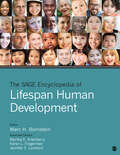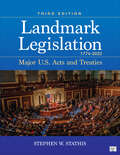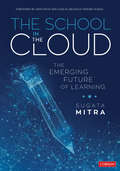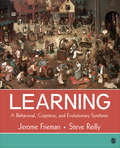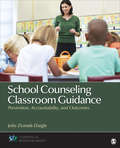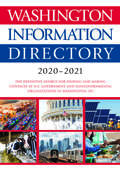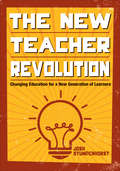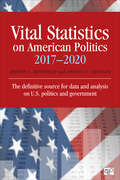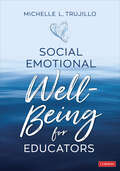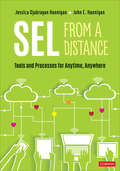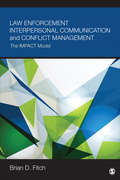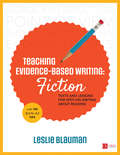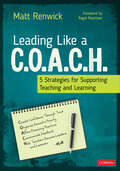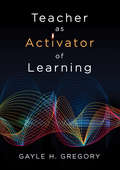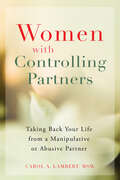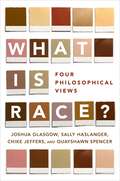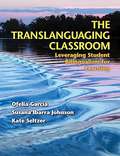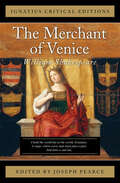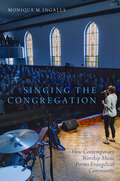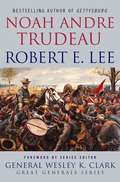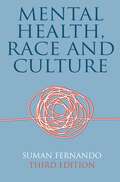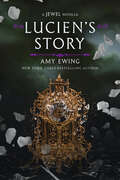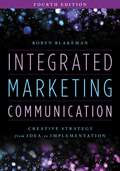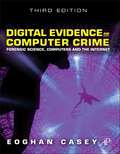- Table View
- List View
The SAGE Encyclopedia of Lifespan Human Development
by Marc H. BornsteinLifespan human development is the study of all aspects of biological, physical, cognitive, socioemotional, and contextual development from conception to the end of life. In approximately 800 signed articles by experts from a wide diversity of fields, The SAGE Encyclopedia of Lifespan Human Development explores all individual and situational factors related to human development across the lifespan. Some of the broad thematic areas will include: Adolescence and Emerging Adulthood Aging Behavioral and Developmental Disorders Cognitive Development Community and Culture Early and Middle Childhood Education through the Lifespan Genetics and Biology Gender and Sexuality Life Events Mental Health through the Lifespan Research Methods in Lifespan Development Speech and Language Across the Lifespan Theories and Models of Development. This five-volume encyclopedia promises to be an authoritative, discipline-defining work for students and researchers seeking to become familiar with various approaches, theories, and empirical findings about human development broadly construed, as well as past and current research.
Landmark Legislation 1774-2022: Major U.S. Acts and Treaties
by Stephen W. StathisLandmark Legislation 1774-2022, Third Edition is a comprehensive guide to important laws and treaties enacted by the U.S. Congress. This updated edition includes landmark legislation from the last five Congresses (2013-2022) on issues like climate change, criminal justice, education, and more. It features carefully selected acts and treaties with historical significance and has an updated index and bibliography for easy access. A must-have for public and academic libraries with American history or political science collections.
The School in the Cloud: The Emerging Future of Learning (Corwin Teaching Essentials)
by Sugata MitraThe Science and the Story of the Future of Learning Educators have been trying to harness the "promise" of technology in education for decades, to no avail, but we have learned that children in groups—when given access to the Internet—can learn anything by themselves. In this groundbreaking book, you’ll glimpse the emerging future of learning with technology. It turns out the promise isn’t in the technology itself; it’s in the self-directed learning of the children who use it. In 1999, Sugata Mitra conducted the famous "Hole in the Wall" experiment that inspired three TED Talks and earned him the first million-dollar TED prize for research in 2013. Since then, he has conducted new research around self-organized learning environments (SOLE), building "Schools in the Cloud" all over the world. This new book shares the results of this research and offers • Examples of thriving Schools in the Cloud in unlikely places • Mitra’s predictions on the future of learning • How to design assessments for self-organizing learning • How to build your own School in the Cloud • Clips from the documentary, The School in the Cloud Discover the future of learning by digging deep into Mitra’s thought-provoking experiences, examples, and vision.
Learning: A Behavioral, Cognitive, and Evolutionary Synthesis
by Jerome Frieman Stephen ReillyLearning: A Behavioral, Cognitive, and Evolutionary Synthesis provides an integrated account of the psychological processes involved in learning and conditioning and their influence on human behavior. With a skillful blend of behavioral, cognitive, and evolutionary themes, the text explores various types of learning as adaptive specialization that evolved through natural selection. Robust pedagogy and relevant examples bring concepts to life in this unique and accessible approach to the field.
School Counseling Classroom Guidance: Prevention, Accountability, and Outcomes (Counseling and Professional Identity)
by Jolie Ziomek-Daigle"Finally, a text that thoroughly covers the topic of classroom guidance – an effective tool for every school counselor at every school level." –Tiffany Bates, Louisiana Tech University Intended for school counselors to aid in the learning of developmental classroom guidance, School Counseling Classroom Guidance: Prevention, Accountability, and Outcomes teaches the fundamentals, strategies, and research outcomes of classroom guidance programming for comprehensive, developmentally appropriate school counseling programs. The content of this book looks at the history and fundamentals of classroom guidance, how these activities meet CACREP and ASCA standards, how and why activities should be aligned to the larger academic curriculum and state/national teaching standards, recommendations on how to develop and assess classroom guidance units, a sampling of units and lessons, techniques in managing the classroom, and outcome research and trends. School Counseling Classroom Guidance: Prevention, Accountability, and Outcomes is part of the Counseling and Professional Identity Series, which targets specific competencies identified by CACREP (Council for Accreditation of Counseling and Related Programs).
The SAGE Encyclopedia of Lifespan Human Development
by Marc H. BornsteinLifespan human development is the study of all aspects of biological, physical, cognitive, socioemotional, and contextual development from conception to the end of life. In approximately 800 signed articles by experts from a wide diversity of fields, The SAGE Encyclopedia of Lifespan Human Development explores all individual and situational factors related to human development across the lifespan. Some of the broad thematic areas will include: Adolescence and Emerging Adulthood Aging Behavioral and Developmental Disorders Cognitive Development Community and Culture Early and Middle Childhood Education through the Lifespan Genetics and Biology Gender and Sexuality Life Events Mental Health through the Lifespan Research Methods in Lifespan Development Speech and Language Across the Lifespan Theories and Models of Development. This five-volume encyclopedia promises to be an authoritative, discipline-defining work for students and researchers seeking to become familiar with various approaches, theories, and empirical findings about human development broadly construed, as well as past and current research.
Washington Information Directory 2020-2021 (Washington Information Directory)
by CQ PressThe Washington Information Directory (WID) is a topically organized reference resource that lists contact information for federal agencies and nongovernmental organizations in the Washington metro area along with a brief paragraph describing what each organization does related to that topic. In addition, WID pulls together 55 organization charts for federal agencies, congressional resources related to each chapter topic, hotline and contact information for various specific areas of interest (from Food Safety Resources to internships in Washington), and an extensive list of active congressional caucuses and contact details. WID has two appendices, one with thorough information on congresspersons and committees, and the second with governors and embassies.
The New Teacher Revolution: Changing Education for a New Generation of Learners
by Joshua D. StumpenhorstFor 21st Century Educators – The New Rules Of Student Engagement It’s time to throw out the old rulebook. Today’s classroom demands teacher innovation, embracing of new technology, and rejection of outdated practices, especially when someone tells you it’s "always been done" a certain way. Meet Josh Stumpenhorst, recently named Illinois Teacher of the Year. Stumpenhorst’s orthodoxy-challenging methods have produced outstanding student outcomes, and in these pages he details how to maximize teacher effectiveness by thinking outside the box: Build student relationships on trust and respect rather than fear and punishment Rethink homework and letter grades, which—in their current forms—are harming learning Leverage technology by not treating it as a "shiny toy", but rather understand its power as a tool for rapid progress Educators who welcome large-scale change are about to pull ahead of those who don’t. "Josh Stumpenhorst is an all-star teacher. And the advice he provides for his colleagues comes from his own authentic experience in the classroom and from a place of deep respect for students and learning. For new teachers in search of mentoring, this book is the place to start." - Daniel H. Pink, Author "The dynamic changes in society have fundamentally altered our learners, resulting in a system that no longer meets their needs. Josh Stumpenhorst not only provides a plan to right the ship, but backs it up by including numerous strategies that have been successfully implemented." -Eric Sheninger, Author and Award-Winning Principal "Josh clarifies the goals most salient to the teaching profession, while providing solutions to entrenched challenges. Any teacher, new or veteran, will rethink their classroom after reading this book." -Angela Maiers, Educator and Author
Vital Statistics on American Politics
by Jeffrey L. Bernstein Amanda C. ShannonThere is no other source that provides in one place the wide range and depth of insight found in Vital Statistics on American Politics (VSAP), published since 1988. VSAP provides historical and statistical information on all aspects of American politics: Political parties Voter turnout Public opinion Campaign finance Media perspective and influence, congressional membership and voting patterns The presidency and executive branch Military policy and spending Supreme Court and federal court make-up and caseloads Foreign, social, and economic policy In over 230 tables and figures, students and professional researchers will find chapters devoted to key subject areas such as elections and political parties, public opinion and voting, the media, the three branches of U.S. government, foreign, military, social and economic policy, and much more. This book provides a vivid and multifaceted portrait of the broad spectrum of United States politics and policies. Along with updated and new data content, this edition offers brand new data literacy lessons that take a "guide on the side" approach to teach data researchers how to wade through the sea of data and do the difficult work of grappling for the meaning of the data on their own. Lessons include understanding descriptive representation data, comparing data over time, noticing gaps in data, unpacking dichotomies of public opinion, and more.
Social Emotional Well-Being for Educators
by Michelle L. TrujilloLearn how to take self-care off your to-do list! It’s been a rough couple of years for teachers and school leaders. Your ability to be resilient and concentrate on social-emotional learning has been put to the test and now you deserve relief—without the pressure of having yet one more thing piled on your plate. This book’s unique and compelling framework empowers you to practice self-care through thoughts and actions that are within your control, enhancing your well-being without taking on extraneous responsibilities. Features include A checklist for determining your baseline of strengths and needs Self-reflection questions, journaling opportunities, and action-planning exemplars A process for tracking, celebrating, and revising your own tangible objectives Teaching guidance for distance or hybrid education Strategies to share with your students It’s right there in the word: well-being! It isn’t a thing to do, but a way to be. When you integrate the principles of SEL into your everyday life, you’ll be a person of joy, peace, and gratitude — and a more inspired and empowered educator.
SEL From a Distance: Tools and Processes for Anytime, Anywhere
by John E. Hannigan Jessica Djabrayan HanniganMake social and emotional learning a way of being—all day, every day, and in any setting The pandemic and subsequent switch to distance learning combined with recent instances of racial injustice has put a spotlight on the cracks in the practice of social and emotional learning (SEL). More than ever before, schools are shifting their focus and prioritizing SEL competencies—around the nation and the world. The call for compassion has never been greater. To easily and effortlessly build SEL into virtual, blended, or in-person environments, behavior experts Jessica Djabrayan Hannigan and John Hannigan have drawn together a collection of tools and processes for SEL that can be applied in any learning environment. In SEL from a Distance, you’ll learn: The five SEL competencies and dozens of easy to use processes for building skills in each How to identify challenging behaviors and prioritize, define mastery, and teach the SEL skills necessary to address them Tips for identifying, teaching, modeling, and reinforcing SEL skills in a virtual setting Strategies for applying SEL to the needs of your unique learning environment Let this practical, easy-to-use toolkit guide you through embedding these critical SEL competencies into your virtual classrooms and make SEL a way of being for you and your students—anytime, anywhere. Endorsements from the People Who Matter Most: "My teacher told our entire class, ‘if you need someone to talk to, I am here for you.’ This was powerful to hear. I have never had a teacher say that to an entire class before." —Ani, 12th grade, Missouri "My teacher helps us use SEL strategies to relax our brains when we are feeling stressed." —Harmon, 4th grade, California
Law Enforcement Interpersonal Communication and Conflict Management: The IMPACT Model
by Brian Douglas FitchLaw Enforcement Interpersonal Communication and Conflict Management: The IMPACT Model provides law enforcement professionals with a comprehensive, easy-to-follow model designed specifically to improve communications with victims, witnesses, subjects, and other members of the public. Harnessing 30 years of front line law enforcement experience, author Brian D. Fitch outlines practical strategies in a six-step model, IMPACT, which asks professionals to: Identify and master emotions Master the story Promote positive behavior Achieve Rapport Control your response Take perspective When used correctly, this model will help readers communicate and connect more effectively with people in virtually any law enforcement environment.
Teaching Evidence-Based Writing: Texts and Lessons for Spot-On Writing About Reading (Corwin Literacy)
by Leslie A. BlaumanOne in a million. Yes, that’s how rare it is to have so many write-about-reading strategies so beautifully put to use. Each year Leslie Blauman guides her students to become highly skilled at supporting their thinking about texts, and in Evidence-Based Writing: Fiction, she shares her win-win process. Leslie combed the ELA standards and all her favorite books and built a lesson structure you can use in two ways: with an entire text or with just the excerpts she’s included in the book. Addressing Evidence, Character, Theme, Point of View, Visuals, Words and Structure, each section includes: Lessons you can use as teacher demonstrations or for guided practice, with Best the Test tips on how to authentically teach the skills that show up on exams with the texts you teach. Prompt Pages serve as handy references, giving students the key questions to ask themselves as they read any text and consider how an author’s meaning and structure combine. Excerpts-to-Write About Pages feature carefully selected passages from novels, short stories, and picture books you already know and love and questions that require students to discover a text’s literal and deeper meanings. Write-About-Reading Templates scaffold students to think about a text efficiently by focusing on its critical literary elements or text structure demands and help them rehearse for more extensive responses. Writing Tasks invite students to transform their notes into a more developed paragraph or essay with sufficiently challenging tasks geared for grades 6-8. And best of all, your students gain a confidence in responding to complex texts and ideas that will serve them well in school, on tests, and in any situation when they are asked: What are you basing that on? Show me how you know.
Leading Like a C.O.A.C.H.: 5 Strategies for Supporting Teaching and Learning
by Matt RenwickExpand your leadership capacity to help your school reach its potential All schools have the capacity for schoolwide instructional excellence. Schools with leaders who adopt a coaching stance as part of their practice are more likely to realize this success. Leaders achieve success with their teachers, their students, and their families, not alone. Leading like a C.O.A.C.H. reframes the approach to schoolwide change from a leader acting alone to a leader working with a community in which each member contributes their strengths and ideas to improving instruction. Renwick, a well-known blogger and writer on literacy and leadership, encourages school leaders to embody five practices: 1. Create confidence through trust; 2. Organize around a priority; 3. Affirm promising practices; 4. Communicate feedback; and 5. Help teachers become leaders and learners. Throughout this practical guide, readers will find Reflective questions Activities Indicators of success Examples of leaders coaching teachers to excellence Wisdom from the field This book provides new and veteran leaders with a practical approach and easily adoptable ideas for helping their schools realize their full potential.
Teacher as Activator of Learning
by Gayle H. GregoryFlip the Switch! How to Get Students Into Learning Mode Now. In his well-known meta-analysis, John Hattie suggests that facilitating learning is not as effective or powerful as activating learning. In this book Gayle Gregory shows you how to facilitate better and deeper learning. Packed with practical strategies that teachers can use every day to increase student achievement, you will also discover what educational neuroscience says about nurturing a "growth mindset" and creating classrooms that support and encourage students to take risks and "fail forward." Learn how to Foster student dialogue and thinking Orchestrate productive, reflective flexible student groups Develop respectful learning relationships between and among students and teachers Teacher competencies and clarity related to student goals and success criteria, with quality feedback, are essential for student success. This resource will enrich learning environments for students and increase the chance of success for all. "In going from ‘teachers as fount of knowledge’ to ′teacher as facilitator’ the field has overcorrected. Gayle Gregory corrects all that with a comprehensive and deep portrayal of the need for ’teachers to be activators’ of learning in partnership with students. Based on equal measure of research and practice Gregory gives is a compelling set of ideas and tools to maximize student learning and engagement. Read it and hit the ground running!" Michael Fullan, Professor Emeritus, OISE/University of Toronto
Women with Controlling Partners: Taking Back Your Life from a Manipulative or Abusive Partner
by Carol A LambertA controlling or abusive partner can break even the strongest person—unless you know what to look for. Written by an expert in intimate partner abuse and based on her highly successful recovery program for women with controlling partners, this book will give you the strength, courage, and strategies you need to acknowledge the problem and stand up for yourself once and for all—whether you stay or leave the relationship. <P><P> If you have a controlling partner, you aren’t alone. Millions of women suffer psychological abuse at the hands of a spouse or intimate partner during some point in their lives, not fully seeing or knowing what is happening to them. Research shows that psychological abuse affects women’s overall well-being more than physical abuse, is a bigger contributor to inducing fear, and can be a precursor to violence. To make matters worse, having a controlling partner often results in hidden injuries like anxiety, depression, low self-esteem, trauma, and low self-efficacy—feeling like you can’t make a difference in your life. So, where can you turn for help?
What is Race?: Four Philosophical Views
by Sally Haslanger Joshua Glasgow Chike Jeffers Quayshawn SpencerAcross public discourse, in the media, politics, many branches of academic inquiry, and ordinary daily interactions, we spend a lot time talking about race: race relations, racial violence, discrimination based on race, racial integration, racial progress. It is fair to say that questions about race have vexed our social life. But for all we speak about race, do we know what race is? Is it a social construct or a biological object? Is it a bankrupt holdover from a time before sophisticated scientific understanding and genetics, or can it still hold up in biological, genetic, and other types of research? Most fundamentally, is race real? In this book, four prominent philosophers and race theorists debate how best to answer these difficult questions, applying philosophical tools and the principles of social justice to cutting-edge findings from the biological and social sciences. Each presents a distinct view of race: Sally Haslanger argues that race is a socio-political reality. Chike Jeffers maintains that race is not only political but also, importantly, cultural. Quayshawn Spencer pursues the idea that race is biologically real. And Joshua Glasgow argues that either race is not real, or if it is, it must be real in a way that is neither social nor biological. Each offers an argument for their own view and then replies to the others. Woven together, the result is a lively debate that opens up numerous ways of understanding race. Above all, it is call for sophisticated and principled discussion of something that significantly permeates our lives.
The Translanguaging Classroom: Leveraging Student Bilingualism for Learning
by Ofelia García Susana Ibarra Johnson Kate SeltzerThe Translanguaging Classroom: Leveraging Student Bilingualism for Learning shows teachers, administrators, professional development providers, and researchers how to use translanguaging to level the playing field for bilingual students in English-medium and bilingual classrooms. The term translanguaging can be understood in two different ways. From a sociolinguistic perspective, translanguaging can be understood as the dynamic language practices of bilinguals. From a pedagogical perspective, translanguaging can be understood as an instructional and assessment framework that teachers can use strategically and purposefully to: <P><P> Support bilingual students as they engage with and comprehend complex content and texts<br> Provide opportunities for bilingual students to develop linguistic practices for academic contexts<br> Make space for students’ bilingualism and ways of understanding<br> Support bilingual students’ socioemotional development and bilingual identities<br> <P><P> García, Ibarra Johnson, and Seltzer illustrate their translanguaging pedagogy in action with examples from three very different contexts: a 5th-grade dual-language bilingual class taught by a bilingual teacher in New Mexico, an 11th-grade English-medium social studies class serving a predominantly Latino classroom taught by an English monolingual teacher in New York, and a 7th-grade ESL teacher working with students from a variety of linguistic and cultural backgrounds in California. Teachers learn to use translanguaging for instruction and assessment to meet and exceed content and language development standards in their classrooms.
The Merchant of Venice: With Contemporary Criticism (Ignatius Critical Editions)
by William ShakespeareThe Merchant of Venice is probably the most controversial of all Shakespeare's plays. It is also one of the least understood. Is it a comedy or a tragedy? What is the meaning behind the test of the caskets? Who is the real villain of the trial scene? Is Shylock simply vicious and venomous, or is he more sinned against than sinning? Can the play be described as anti-semitic? What exactly is the quality of mercy? Is Portia one of the great Christian heroines of western literature? And what of the comedy of the rings with which Shakespeare ends the play? These questions and many others are answered in this critical edition of one of the Bard's liveliest plays.
Singing the Congregation: How Contemporary Worship Music Forms Evangelical Community
by Monique M. IngallsContemporary worship music shapes the way evangelical Christians understand worship itself. Author Monique M. Ingalls argues that participatory worship music performances have brought into being new religious social constellations, or "modes of congregating". Through exploration of five of these modes--concert, conference, church, public, and networked congregations--Singing the Congregation reinvigorates the analytic categories of "congregation" and "congregational music." Drawing from theoretical models in ethnomusicology and congregational studies, Singing the Congregation reconceives the congregation as a fluid, contingent social constellation that is actively performed into being through communal practice--in this case, the musically-structured participatory activity known as "worship." "Congregational music-making" is thereby recast as a practice capable of weaving together a religious community both inside and outside local institutional churches. Congregational music-making is not only a means of expressing local concerns and constituting the local religious community; it is also a powerful way to identify with far-flung individuals, institutions, and networks that comprise this global religious community. The interactions among the congregations reveal widespread conflicts over religious authority, carrying far-ranging implications for how evangelicals position themselves relative to other groups in North America and beyond.
Robert E. Lee: Lessons in Leadership (Great Generals)
by Noah Andre TrudeauAn insightful new account, Robert E. Lee delivers a fresh perspective that leads to a greater understanding of one of the most studied and yet enigmatic military figures in American history. <P><P> General Robert E. Lee was a complicated man and military figure. From his birth as the son of a celebrated and tragic Revolutionary War hero, to his career after the Civil War when he led by example to heal the terrible wounds of the conflict, there is much to learn from this celebrated general. In just three years of service, he directed the Confederacy's most renowned fighting force, the famed Army of Northern Virginia, through a series of battles, including Second Manassas, Antietam, and Gettysburg, which have since come to define combat in the Civil War.
Mental Health, Race and Culture
by Suman FernandoThis powerful text offers a unique analysis of the impact of race and culture on contemporary issues in mental health. Drawing on extensive international experience, Fernando challenges the traditional ideas that inform practice in clinical psychology and psychiatry in order to promote new and alternative ways of thinking. Covering both theoretical perspectives and practical implications, this insightful text discusses perceptions of ethnicity and identity, compares practices around the world and looks at racism in mental health services. <P><P> This fully revised, expanded and updated edition of a seminal text offers students and practitioners alike a comprehensive and reliable study of both western and non-western psychiatry and mental health practices.
Lucien’s Story: (A Jewel Novella)
by Amy EwingReturn to the Lone City with an eagerly anticipated new story in the New York Times bestselling series that started with The Jewel. From acclaimed young adult author Amy Ewing comes the gripping tale about Lucien’s past and how he went from elite lady-in-waiting to the leader of a revolution. To save his city, he’ll have to risk everything… <P><P> Lucien’s only goal is to keep his sister, Azalea, safe from the clutches of the royalty, who rule from within the glittering walls of the Jewel. So of course, he dismisses her pleas to start a revolution and free the people of the Lone City from the royalty’s control.
Integrated Marketing Communication: Creative Strategy from Idea to Implementation
by Robyn BlakemanNow in its fourth edition, this comprehensive text offers a classroom-tested, step-by-step approach to the creative processes and strategies for effective integrated marketing communication (IMC). Robyn Blakeman covers key areas, from marketing plans, branding/positioning, and creative briefs to copywriting, design, and considerations for each major media format. Throughout, the book explores visual and verbal tactics, along with the use of business theory and practices and how these affect the development of the creative message. This user-friendly introduction walks students through the varied strands of IMC, including advertising, PR, direct marketing, and sales promotion, in a concise and logical fashion.
Digital Evidence and Computer Crime: Forensic Science, Computers, and the Internet
by Eoghan CaseyDigital Evidence and Computer Crime, Third Edition, provides the knowledge necessary to uncover and use digital evidence effectively in any kind of investigation. It offers a thorough explanation of how computer networks function, how they can be involved in crimes, and how they can be used as a source of evidence. In particular, it addresses the abuse of computer networks as well as privacy and security issues on computer networks. This updated edition is organized into five parts. Part 1 is about digital forensics and covers topics ranging from the use of digital evidence in the courtroom to cybercrime law. Part 2 explores topics such as how digital investigations are conducted, handling a digital crime scene, and investigative reconstruction with digital evidence. Part 3 deals with apprehending offenders, whereas Part 4 focuses on the use of computers in digital investigation. The book concludes with Part 5, which includes the application of forensic science to networks. New to this edition are updated information on dedicated to networked Windows, Unix, and Macintosh computers, as well as Personal Digital Assistants; coverage of developments in related technology and tools; updated language for search warrant and coverage of legal developments in the US impacting computer forensics; and discussion of legislation from other countries to provide international scope. There are detailed case examples that demonstrate key concepts and give students a practical/applied understanding of the topics, along with ancillary materials that include an Instructor's Manual and PowerPoint slides. This book will prove valuable to computer forensic students and professionals, lawyers, law enforcement, and government agencies (IRS, FBI, CIA, CCIPS, etc.). - Named The 2011 Best Digital Forensics Book by InfoSec Reviews - Provides a thorough explanation of how computers & networks function, how they can be involved in crimes, and how they can be used as evidence - Features coverage of the abuse of computer networks and privacy and security issues on computer networks
